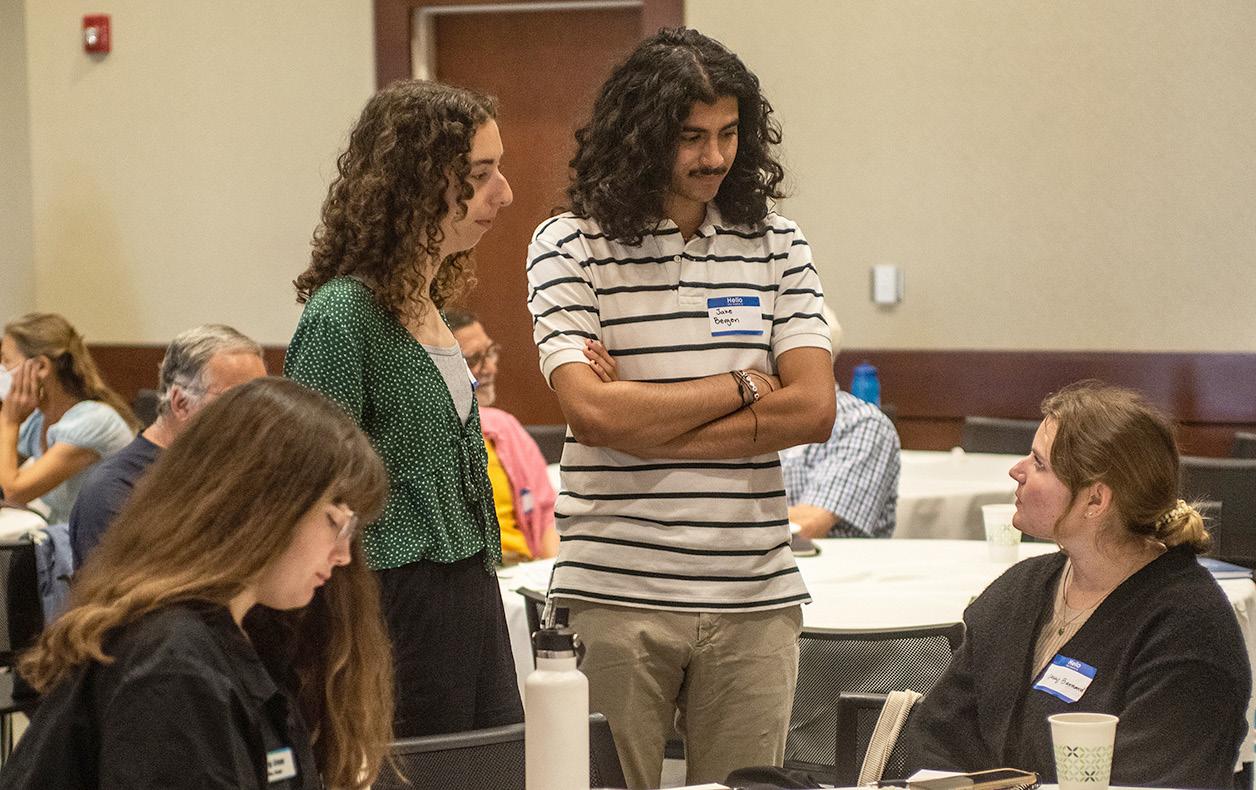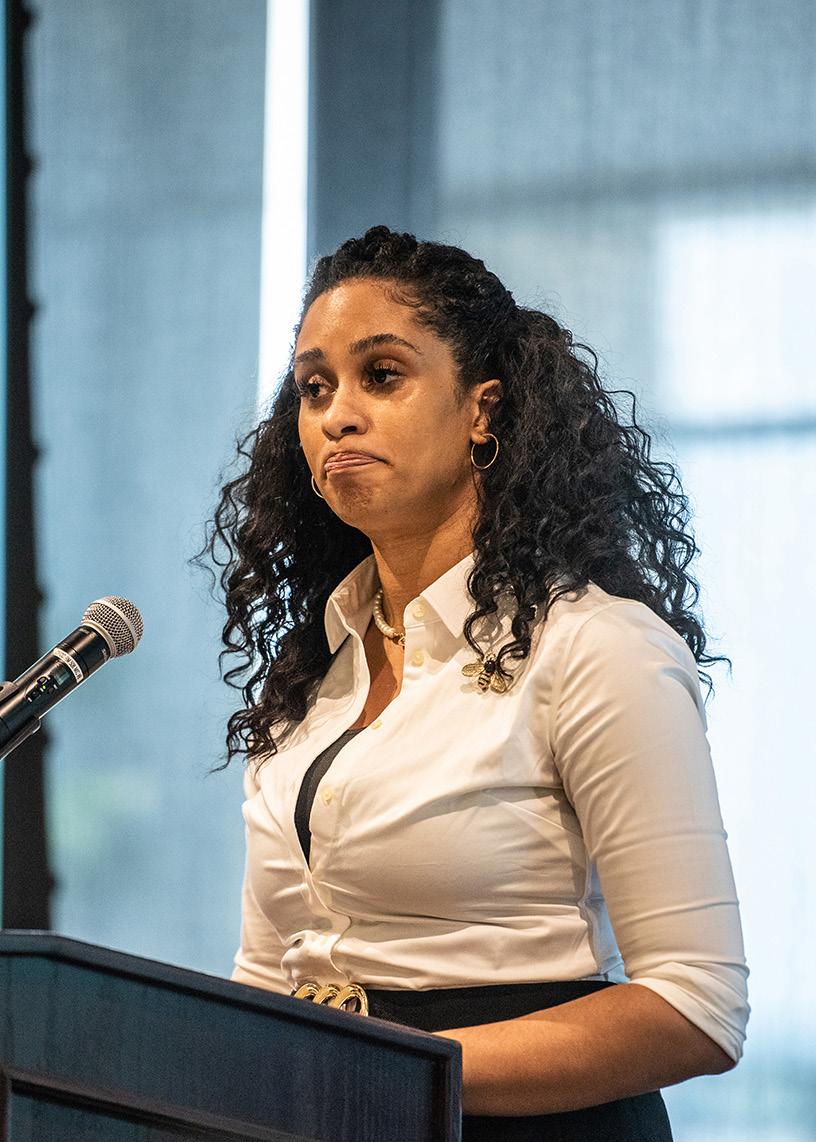
6 minute read
Cape Fear River Watch Hosts First State of the River Forum
state of the river Cape Fear River Watch Hosts First State of the River Forum
by Shelby Diehl
The Cape Fear River is facing multiple crises from rising water levels to habitat destruction to chemicals in the waterway. Cape Fear River Watch (CFRW) understands this. So, to spread awareness throughout the community, CFRW hosted their first ever State of the River. The forum, hosted on June 1, 2022, brought together over one hundred attendees.
The forum opened with a pre-recorded speech from Attorney General Josh Stein. In his video, Stein touched on Cape Fear River Watch’s work and acknowledged the state of the Cape Fear River, especially concerns over GenX contamination. He closed with the environmental work that his team is doing in order to help the river.
After the video, President of the NC NAACP Deborah Dix-Maxwell gave remarks highlighting the importance of preserving the river.
“We have to protect and preserve what is left of the quality of not only the river, but all of our ecosystem within this beautiful place we call New Hanover County in North Carolina,” said Dix-Maxwell. “We can flop here all we want to, but if we do not preserve the sanctity and the fragility of the river, of the ocean, of the land, we’re just gonna be another Rehoboth Beach¹.”
Dix-Maxwell was followed by Cape Fear Riverkeeper Kemp Burdette who illuminated the Cape Fear River Watch mission and recognized the upcoming 50th anniversary of the Clean Water Act. This act—which enacted strict regulations on pollution and quality controls for waterways across the nation—became a law on October 18, 1972.
Roger Shew, CFRW Board Member and University of North Carolina Wilmington (UNCW) Senior Lecturer, was the first presenter of the morning. His presentation titled, “Lower Cape Fear River Estuary Current Status and Future Projections” dove into the natural areas, history and problems threatening the Cape Fear’s estuary.
The estuary, spanning 30 miles in width, is a critical habitat, and the chang in wetlands happening due to rising water levels is threatening natural ecosystem services including fisheries, heritage and flood protection, among others. Shew further touched on the dredging of the Cape Fear River, highlighting the planned five-foot excavation that will bring the river down to 47 feet in depth, which will cost approximately $884 million.
Dawn York, Cape Fear River Partnership Coordinator and Coastal Scientist, followed Shew with a presentation titled “Returning Fish to Historical Spawning Grounds.” The presentation educated attendees about the Lock and Dams #1, #2 and #3 of the Cape Fear River and how the dams impact
photo by Alan Cradick Attendees chat prior to the State of the River forum in Cape Fear Community College’s Windell Daniels Hall. From left, Shelby Diehl, Maiya Baum, Jake Bergen and Casey Barnard. fish passages. Specifically, York focused on Lock and Dam #1, a dam with the first fish passage of its kind on the East Coast.
With the remainder of her time, York highlighted the Cape Fear River partnerships that helped improve Lock and Dam #1, and she discussed the ongoing fish passage monitoring occurring in spring 2022. She closed the presentation with the next steps for Lock and Dams #2 and #3 and the federal funding opportunities that may assist in improving these systems.
Later, Dana Sargent, CFRW Executive Director, took to the podium for her presentation “PFAS Contamination.” Her early slides set a foundation for understanding PFAS² (per- and poly-fluorinated alkyl substances) and provided graphics listing the health impacts of PFAS for humans and animals. Then, Sargent presented a timeline of PFAS contamination in the Cape Fear River beginning in the 1950s and detailing each major event to date, including CFRW and their partners suing the EPA for failing to protect people from pollution.
Sargent provided more detail on PFAS and the progress under the 2019 consent order between Chemours, CRFW (represented by the Southern Environmental Law Center) and the NC Department of Environmental Quality. At the end of her presentation, Sargent listed options for the public of what they can do to help fight PFAS pollution in the Cape Fear River. These include showing support for House Bill 1095³, being a smart consumer, voting and joining CFRW’s email list. She also recommended contacting EPA Administrator Micheal S. Regan about the need to fund health studies in the area and the need for a class approach to (and regulation of) PFAS.
Riverkeeper Kemp Burdette gave the last presentation of the forum titled, “Contamination from Concentrated Animal Feeding Operations.” In his lecture, he laid out the negative impacts of concentrated animal feeding operations (CAFOs) beginning with the environmental impacts on the counties with the highest concentrations: Duplin and Sampson counties. His graphics walked attendees through these facilities, highlighting the harmful waste lagoons seeping into the river.
Burdette shifted his focus to legislative and cultural issues when he discussed the rural economies suffering from these operations. He attributed a lack of change
River forum (continued)
in these areas to pro-agriculture laws and policies on top of the industry ignoring existing weak legislation. Burdette concluded by recognizing that there is no easy fix to CAFOs contamination, but that people can opt to support local sustainable farms.
Following lunch and networking, four panelists took time to answer audience questions. The panel featured Sherri White-Williamson (Environmental Justice Policy Director at NC Conservation Network), Kerri Allen (Coastal Advocate and Senior Manager at NC Coastal Federation), Jean Zhuang (Staff Attorney at Southern Environmental Law Center) and Dr. Detlef Knappe (Distinguished Professor at NC State University).
The panelists answered questions clarifying aspects of earlier presentations, especially pertaining to legislation, inequities in Duplin and Sampson counties, Chemours, stormwater monitoring programs and how to destroy PFAS waste.
La’Meshia Wettington, the NC Black Alliance/Democracy Green’s Deputy Director, presented the forum’s closing remarks. Her passionate call to action had the room clinging to her every word. The speech resulted in a standing ovation from the audience and quite the memorable end to the first of many State of the River forums.
“We are tasked to be stewards of the earth and that of each other because polluted air doesn’t stop flowing,” said Wettington. “Once it reaches the black neighborhoods, contaminated water doesn’t stop flowing because it reaches a Hispanic neighborhood .... But the pathway to victory, resilience and survival runs through our blood. Same as the river runs through our communities, [providing] sustenance for the fight that lies ahead. And everyone here, we must protect our food.”




photo by Alan Cradick La’Meshia Wettington presented the forum’s closing remarks.
Footnotes
1 Since 1998, the city of Rehoboth Beach,
Delaware has been under a judge’s order to stop dumping wastewater from the
Rehoboth Beach Wastewater Treatment
Facility into the canal and Rehoboth Bay.
It caused heavy nutrient pollution—phosphorus and nitrogen created by human and animal excrement. To learn more, read “In scenic Rehoboth Beach in Delaware, a proposed sewer outfall causes nasty fallout” by
The Washington Post at wapo.st/3Hx0ZC6. 2: See “Accessing Clean Water in the Age of
GenX” on page 5 to learn more about PFAS. 3: House Bill 1095, “PFAS Pollution and
Polluter Liability,” would force Chemours, the Fayetteville chemical plant responsible for contaminating the river, to pay installation and operation costs of water treatment technology. It also would tighten penalties on the PFAS polluters. To learn more, read
“Proposed legislation could force Chemours to pay” by Port City Daily at bit.ly/3tHTJxA. Shelby Diehl is a senior at the University of North Carolina Wilmington studying environmental science with a concentration in conservation and creative writing with a certificate in publishing. She is a Going Green contributing editor and plans to pursue a career in environmental writing that will allow her to advocate for environmental causes worldwide.










